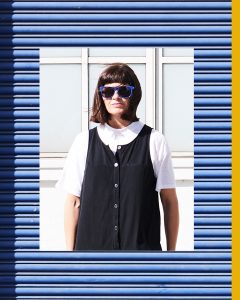Interview Series: Lee Coventry-Walsh Published on by luis in Interviews, Stock Performer
 For today’s interview, we are happy to welcome Lee Coventry-Walsh, an experienced Art Director and founder of Plume Creative.
For today’s interview, we are happy to welcome Lee Coventry-Walsh, an experienced Art Director and founder of Plume Creative.
Tell us, where do you live and where are you from? Is that where your business is headquartered?
I’ve lived in London for the past 20 years, but was actually born in Scotland and grew up in Australia. Our business is based here in London.
You have been involved in the creative visual industry for long, including 10 years as an Art Director at Getty Images. How has the industry changed during that time?
The industry has changed in so many ways. The thing that’s really struck me lately is this tension between the fetishisation of photography through apps like instagram and the value that we all place on capturing and consuming amazing imagery vs. the commoditization of photography where it has become so throwaway and devalued. It’s getting harder and harder to create a certain type of content and make it financially viable.** **
Over the years, identifying up-and-coming trends has been an important part of your work. How do you go about identifying a trend? How do you know when it is at its best? And when do you know a trend is over?
Who was it that said ‘fortune favours the prepared mind’? I think anyone working in a creative capacity in the content creation world has a real advantage if they’re a curious, eager consumer of popular culture. I subscribe to a lot of trend forecasting sites, I attend trend events, there are several media platforms that visit daily, I listen to loads of podcasts, I go to exhibitions, I get sent inspiring and interesting things from friends etc.
When you immerse yourself in that it becomes quite obvious when a trend starts to emerge. For me it’s about being a sponge and having a lot of references to draw from and then connecting the dots. For me, knowing when a trend is on the up is a bit like watching an image come into focus. One minute it’s just a blur of colour and disparate parts and then slowly a picture starts to emerge and you can kind of make sense of it. Over time that picture becomes more visible and obvious.
I guess you know a trend is over when you see it everywhere because it’s been adopted so ubiquitously by brands. It becomes a kind of shorthand for a particular philosophy or message. Like the whole hipster beard trend – from a few years back – in the beginning the whole craft, meets folksy beard thing was the ultimate way of showing millennial cool and after a couple of years it became almost as much of cliche as woman laughing with salad.
You are also a contributor of stock imagery and videos to Getty Images. Once you identify a trend, how difficult is it to actually produce an original image or video to cater for that trend? How do you go from identifying a trend to actually delivering content for that market?
When I realise something isn’t just a one off thing and feel instinctively that it’s going to be a trend worth pursuing I get super excited. I gather up some references and figure out how I want to interpret the trend. Once I’ve come up with a few options I get together with Jonny – my partner in Plume for a chat. If he’s up for it and is interested in the idea we develop further and try to get a date in to shoot as soon as possible.
The beauty of living in London is that if you have an idea for a project everything is on your doorstep in order to bring that to life pretty quickly.
**A lot of data is involved in the creative stock business. From search data, sales data to upload data. How important do you think such data is for this business? Is it being used to its full potential today? **
Data is definitely important for the business, we’re still quite a small producer but understanding which shoots and individual shots perform well informs our strategy. It’s a solid jumping off point for some shoots but It’s not the whole picture, as that data only tells you what has sold in the past, not necessarily what will be saleable in the future. You have to build in space for creativity and risk taking otherwise where’s the fun?!
I can see that from a large organisation’s perspective data is extremely important, search data in particular is a really good early indicator in identifying new themes and ideas that customers are looking for and possibly can’t find.
Your account on Getty is under the name Plume Creative. What motivated you to become a contributor?
I was working at Gallery Stock for a few years and then unfortunately was made redundant when they wound down the london office in November 2017. After working for organisations my entire career I thought it was the perfect time to change things up and try the freelance life for a while.
I have two young children and the idea of being able to spend a bit more time at home with them and have more flexibility in my work was really appealing. It was a no brainer in terms of thinking, I’ve been helping photographers create saleable work for libraries all these years, I should totally do this for myself!
How important is data for your trend analysis and your decision-making process? How do you integrate Stock Performer into your workflow?
Stock Performer is a great way to see very quickly and easily which of our shoots and individual images are selling. It helps us to budget for future productions and of course think about the types of subjects that are worth revisiting and updating.
What features in Stock Performer provide you the most valuable insights, and why?
The ability to slice the sales info in multiple different ways is really great, it gives you such a holistic picture. I find the ability to put shoots into collections and then review the performance of that shoot as a whole really useful. I also love that the interface is very visual and that you can see at a glance which specific images have been downloaded the most often and have generated the most revenue overall.
Tell us about how Plume Creative is setup and what your production process looks like? How many people are involved?
As a company, we’re about as lean as you can get! There’s myself and the photographer Jonny Storey. Jonny shoots most of our content, and from time to time bring in a second photographer to get a bit more coverage. In terms of our production process, being only two of us, it’s fairly relaxed, we find shooting in blocks of 3 days works well for us, and then we do the odd adhoc day here and there if an opportunity comes along to shoot a particular person or group that we’ve been hounding. We don’t stick to a rigid content plan or schedule and we fit in our Plume work around other things.

Thank you for photo. What inspired you to take take that picture?
A big part of our aim with Plume is to ‘help brands to craft richer stories through more diverse cultural and social representation.’ I remember seeing a number of baby shots featuring in Getty’s top performing images when I was an Art Director there. The thing that struck me was that they were all caucasian and it was a no brainer figuring out that replicating the style of those shots with a child from a different ethnic background should be really saleable. Particularly with diversity and inclusion being such a key value for brands.
What does this image’s revenue chart tell you?
It shows us that there’s been real value in the RM model which we will miss. And also shows that sometimes you’re so ahead of the curve that it takes a while for customers to catch up. This image didn’t sell for the first 4 years! But it proves to me that if you’ve done your research, get ahead of the curve on trends your content will eventually connect with the right customer.

Did you expect such a revenue chart? Are you happy with it?
We didn’t expect such a large return from a single sale, we were hoping for a more consistent return. But we’re really happy and relieved with the return. We’ve also been approached directly by a nappy brand to create new content for them in a similar style after they’d licensed some images from this shoot on a previous project.
People think that the stock photography market is oversaturated with content. Do you agree?
To a point, there’s so much content available for brands looking to license imagery now. From a client perspective it’s fantastic, but it also means that curation is more valuable than ever. If you’re making relevant work and partner with an agency that curates and markets that work effectively, there are still great opportunities for sales.
In your opinion, how can contributors remain competitive and profitable in today’s market?
With the proliferation of so much content and the lowering of prices due to the popularity of subscription and the RF models it is a lot harder to create a certain type of content and make it financially viable. There’s a lot more hustling that has to go on now, working with ‘real people’ thinking about ways of negotiating fees for locations etc. that don’t break the bank.
Contributors now expect lower return on inverstment per image and rely on higher volume sales, so applying that model to talent fees is a good way to stay competitive. i.e. – work with the same people on multiple projects – pay them a more competitive rate per shoot but promise them the opportunity to work on 3 or 4 projects. I also recommend doing deals with model agencies, offer to shoot some portfolio shots for new signs in return for a few shots and a signed model release for yourself.
Where do you think the stock business is going? How do you see the next years?
The past 5 years have seen massive changes – A lot of the large agencies have already introduced custom content products, using their network of contributors to create custom or branded content at stock rates. There’s been a big push towards exclusive content and I think that will continue to be a big differentiator for agencies and of course video – I think you’d be mad not to get onboard with that.
Tell us, when you are not doing photography, how do you relax and enjoy your free time?
Any parent of young children will tell you that free time is very rare! I spend a LOT of time on the sides of football pitches, tennis courts and swimming pools. When I do get some time I love to visit exhibitions, and design events. And If I have a spare hour, a pint in our local with my partner feels like a real luxury. There’s so many cool things going on in London that you’re never short of options if you have the time.
Thank you very much!
You enjoyed this interview? Then read more here: Interview Series
Sign up to Stock Performer and see how we can help you make more money. The first month is completely free!